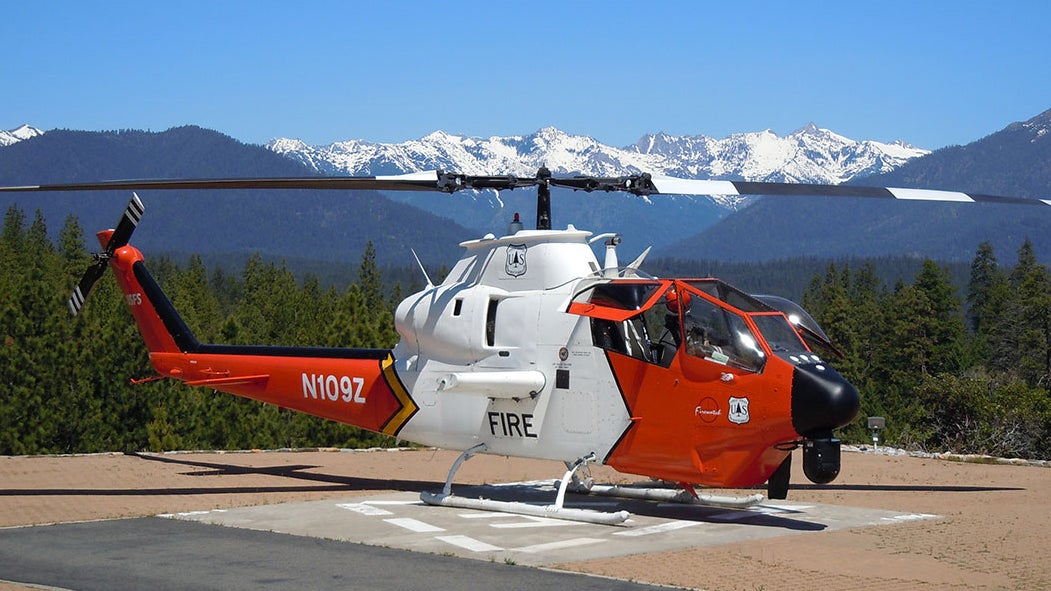An iconic aircraft has been stood down from its duty in support of aerial firefighting operations, with the retirement of the adapted AH-1 Cobra helicopter gunships operated for almost two decades by the U.S. Forest Service. The red-and-white painted AH-1s had been used as firewatch aircraft, using a variety of sensors to monitor the progress of wildfires and report their progress to firefighters on the ground, as well as to help coordinate operations.
The two firewatch AH-1s were officially retired last Saturday, according to the Fire Aviation website. The Cobras were ex-U.S. Army AH-1F gunships that had been supported in their new civilian mission using spare parts from the boneyard at Davis-Monthan Air Force Base, Arizona.
Originally, the U.S. Forest Service acquired 25 former U.S. Army AH-1Fs, with most of the others being stored at Davis-Monthan. Despite this reserve of parts, the active helicopters were showing their age, with maintenance becoming increasingly challenging for the aircraft. The final two firewatch Cobra airframes were originally built in 1969 and 1983.
With all remaining easily accessible parts having been expended, it was considered no longer cost-effective to keep the Cobras flying.
It’s important to remember these single-engine Cobra variants have more in common with those that saw action in the Vietnam War and during the Cold War than they do the twin-engine AH-1s that have been flown in combat by the U.S. Marine Corps in recent years, the now-retired AH-1W, and the current AH-1Z. That said, with the aid of comprehensive upgrades, AH-1F variants do remain in frontline military service outside the United States.
Despite their unique characteristics, the U.S. Forest Service is adamant that their retirement won’t adversely affect firefighting in the region. “There is no reduction in firefighting surveillance or operational capabilities with the transition,” the organization told Fire Aviation. “Local communities and wildland firefighters will be better served by the advancements in modern technology. [The two Cobras] served the Forest Service for 19 years and reached their maximum lifespan after flying approximately 7,600 flight hours with the Cobra program.”
Footage from the latest fire season in California, including firewatch Cobras in action:

The firewatch Cobras were uniquely equipped for their task. According to Fire Aviation, the AH-1s “were outfitted with infrared sensors so that they can be used for close intelligence support for ground troops, GIS [geographic information system] mapping, real-time color video, geo-referenced infrared, and infrared downlink.”
The infrared sensors comprised a FLIR Star SAFIRE 380-HDc gimbal on each helicopter. These, according to the sensor manufacturer, allow the flight crew “to see through smoke, report real-time fire progression, provide tactical infrared capabilities to enhance ground resources’ situational awareness, and keep incident management apprised of critical holding issues.” The ability to see through smoke, in particular, was a major advantage when the firewatch Cobra appeared on the scene.

In addition to intelligence gathering, they were also used as a platform for an Air Tactical Group Supervisor (ATGS) or a Helicopter Coordinator, essentially serving as an on-scene coordinator for aerial firefighting operations.

In an earlier report about the Cobras, Fire Aviation explained, “The Cobras have a ROVER system that can transmit and receive data to and from a hand-held device about the size of an iPad mini, but not as thin as an iPad. For example, an Operations Section Chief could draw on a map on the screen of the portable device to illustrate where he wants an air-drop, or the location of a stream that needs to be protected from retardant drops, and his drawings would show up on a screen in front of the pilot. The data is carried by a microwave link.”
ROVER, or Remotely Operated Video Enhanced Receiver, has encompassed several generations since its introduction in the mid-2000s and was essentially the first system of its kind to provide a robust means of sharing visual information between forward air controllers on the ground and military aircraft. The many advantages that the system offers on the battlefield can equally be exploited to combat wildfires.
This walkaround of one of the last two firewatch Cobras is well worth a watch:

The U.S. Forest Service confirmed also that the same kinds of capabilities will be introduced to a “high-performance Type III helicopter for next fire season.” According to the National Interagency Fire Center classification, Type III helicopters are typically small and fast and are expected to arrive on the scene of an initial wildfire outbreak faster than other rotorcraft. In addition, they should be capable of carrying four to five firefighters at a time, and use a 180-gallon water bucket, although it’s not clear if the intended replacement for the AH-1 will also have transport and water-drop capabilities.
In addition, it’s expected that the U.S. Forest Service will rely more heavily in the future on fixed-wing aircraft that can monitor a broader area, as well as drones, which are becoming an increasingly important aerial firefighting tool.
So, it’s farewell then, to the famous AH-1 Cobra in the firefighting role. Adapting these menacing rotorcraft for a peacetime mission is typical of the often innovative approaches that have been taken to tackling wildfires in North America and it’s hoped that their capabilities will continue to be provided by whatever helicopter type succeeds them.
Contact the author: thomas@thedrive.com
